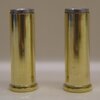3rdTennCoB
Member
- Joined
- Mar 13, 2020
- Messages
- 7
Hello all,this is the first handgun cartridge I want to reload for. Just bought a vintage colt cobra and wanna put lots of lead down range with her but want to go easy on her frame so she will last for years
What I'm thinking was starting with a 2 grain charge of hp38 and working up to 2.9 or 3 grains. I was looking g to cast my own 148g HBWC's and seating them at or close to max OAL to get it close to the forcing cone. Was wondering if any avid or veteran hand loaders out there can give me any critique. Bullet seat depth? Powder charge issues? Any filler for light loads? This is the first load I was thinking of whipping up but not sure if I'd run into any ignition problems or any over pressure problems
I have heard recommendations of red dot or trailboss for light recoil loads but with the coof going around, neither are available at the moment, but again I do have hp38
What I'm thinking was starting with a 2 grain charge of hp38 and working up to 2.9 or 3 grains. I was looking g to cast my own 148g HBWC's and seating them at or close to max OAL to get it close to the forcing cone. Was wondering if any avid or veteran hand loaders out there can give me any critique. Bullet seat depth? Powder charge issues? Any filler for light loads? This is the first load I was thinking of whipping up but not sure if I'd run into any ignition problems or any over pressure problems
I have heard recommendations of red dot or trailboss for light recoil loads but with the coof going around, neither are available at the moment, but again I do have hp38




